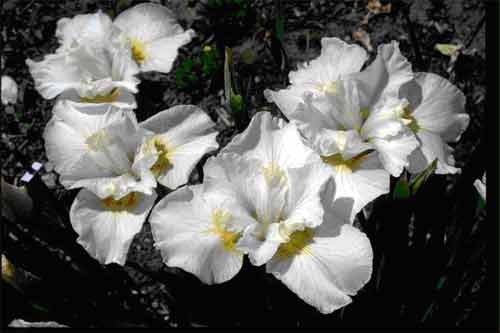
| Main page | |
| Iris for Minnesota Gardeners | |
| Bearded | |
| Beardless | |
| Rebloomers in our area | |
| Events | |
| Calendar | |
| Shows | |
| Dig & Sale | |
| Display gardens | |
| Public | |
| Bylaws | |
Siberian Iris Culture

Sub-series Sibiricae – Throughout this culture sheet the 28-chromosome group comprising species I. sibirica, I. sanguinea, I. typhifolia, and their hybrids will be called “garden” Siberian iris.
Sub-series Chrysographes - The 40-chromosome group comprising eight species and their hybrids will be called “Sino-Siberian” iris.
Climatic Conditions
Garden Siberians:
The\se species and hybrids are adaptable to a wide range of climatic
conditions and are very cold hardy. I. sanguinea is
native to Siberia. They flourish in all temperate regions with sufficient
rainfall. They are more difficult to grow in hot arid locations requiring
special conditions such as semi-shade, extra mulch, and abundant water.
Established clumps do not require winter protection with mulch.
USDA
Zones 3-9
Sino-Siberians: Native to high altitude meadows and streams in the
Himalayas. The species are not subject to either temperature extremes.
Summers are cool and winters are mild with ample moisture and humidity.
In northern climatic zones heavily mulch in the winter. Mulch to prevent
moisture loss in hot climates.
USDA Zones 4-8
Site Preparation and Soil Requirements
Both sub-series of Siberian Iris have the same site and soil requirements.
These irises like full sun except in hot arid regions. They can tolerate
some shade, but less than half a day of sun will be met with a reduction
in bloom and vigor. They tolerate a wide range of pH, but prefer
neutral too slightly acidic conditions, pH 5.5 to 6.5 is best. They
can languish or dwindle in alkaline soil. They prefer rich soil with
ample organic matter. Thoroughly composted manure, peat moss, and
other organic materials make excellent soil amendments. They like
abundant moisture and early in the season can withstand flooding
for short periods of time, yet they are not water iris and a site
should have adequate soil drainage.
Planting
Prepare iris for planting by cutting leaves back to 6 or 8 inches and soak the roots for several hours before planting. Remove damaged roots and rhizomes. Inspect the roots for intertwined weed or grass roots and remove them.
Planting can be
as simple as making a hole wide and deep enough to receive the root
system.
The base of the leaf system or crown should
be roughly 1” below the final level of soil. Make sure no air
pockets remain around the root system. Thoroughly water the iris at
the time of planting and for the first couple of months after planting,
not allowing the plant to become dry. Additional culture can increase
performance such as spreading roots over a mound of thoroughly composted
manure in the base of the hole and applying a weak solution of root-stimulating
hormone.
Traditionally early fall is the best time for planting bare root
material giving roots and rhizomes chance to anchor before winter.
In northern regions Spring planting can be successful. Within your
garden transplanting with a root ball of soil avoids transplant shock.
Spring planted Siberians may be expected to flower the following
year. Fall planted iris cannot be expected to flower until the second
year.
To maintain abundant bloom and vigorous growth you can transplant Siberians every five to ten years. Divide clumps with fork or spade and remove old roots and rhizomes from the center. Transplant the outer portions as you would new plants.
Water
All Siberian irises like abundant water during the growing season, 1” of water weekly is recommended.
Established garden Siberians can tolerate dry conditions later in the season. Some growers flood Sino-Siberians every 3 to 4 days during the growing season if conditions are dry. Do not allow newly planted stock to dry out.
Fertilizer
Siberian Irises are moderate feeders. A minimum program of balanced 10-10-10 granular fertilizer may be applied as new growth appears, just after bloom, and once in early fall. Fertilizer should not be applied to new plantings for a month. Some growers apply soluble fertilizer twice in early spring, once before bloom, after bloom, and in early fall.
Mulches
Mulching provides four advantages: Controlling weeds, conserving water in the soil, moderating soil temperatures, and winter protection. Pine needles, shredded leaves, wood chips, pine bark, straw, and peat moss are excellent choices. New plantings should be mulched the first year to moderate soil temperatures while roots and rhizomes increase. Mulching also prevents heave from winter freeze and thaw cycles. Though always beneficial, well-established plantings may only need mulching for weed control. In areas of climate extremes Sino-Siberians should be heavily mulched for moisture retention and winter protection.
Additional Culture
Flower stems and unwanted seedpods may be removed so the plant will return energy to root and rhizome growth.
Foliage should be cut and removed in the fall after turning brown. This removes sources for future pest, fungus, and disease contamination.
Book of Secrets Photo Copyright - Jan Sacks and Marty Schafer Written: W. Dougherty